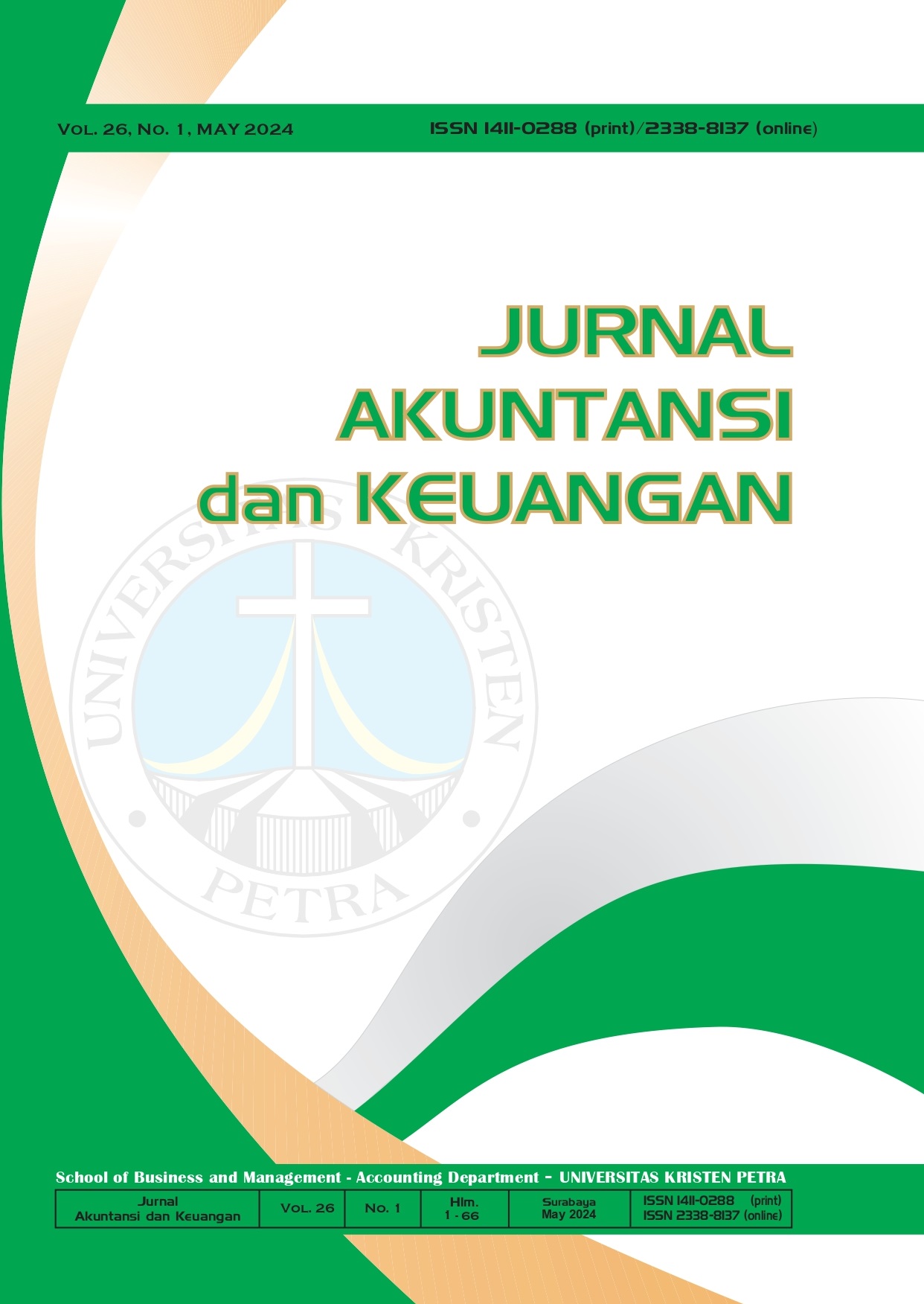Board Size and Firm Performance: The Moderating Role of Female Representation
DOI:
https://doi.org/10.9744/jak.26.1.18-28Keywords:
Board size, females in the board, firm performance, board of commissionersAbstract
This research aims to investigate the commissioner’s number of boards on the Indonesian go-public company’s performance. The disparity in types of gender begs the question of whether the applicability of women’s governance may lead to firm performance. So, the women's presence on that effect as the moderating factor is also examined and analyzed using panel data regression and ordinary least squares in this research. The study's samples are non-financial firms from 2015 until 2019, with 1210 observations. The commissioner's number of boards significantly affects Tobin's q and the market-to-book value ratio as the business performance measurement. Yet, the women’s board of commissioner’s proportion as the moderating factor did not affect the relationship between the commissioner's number of boards and the Indonesian go-public company's performance because of the small number of women on the board. It remains negligible since the dominant gender in the board of commissioners is men in Indonesian non-financial go-public companies, so the women directors may not improve the company’s performance. This study will help various businesses in various sectors by shedding light on the ideal board size for boosting productivity. It also acknowledges the significance of gender diversity on boards so that companies may make educated decisions about their boards' makeup and governance procedures. Given that women make up the minority of CEOs, policymakers will utilize these findings to create rules and directives that support gender diversity on boards and enhance business performance.
References
Adams, R. B., & Ferreira, D. (2009). Women in the boardroom and their impact on gover¬nance and performance. Journal of Financial Economics, 94(2), 291–309. https://doi.org/10.1016/j.jfineco.2008.10.007
Adinegara, G., & Sukamulya, S. (2021). The effect of good corporate governance on the market value of financial sector companies in Indonesia. Jurnal Akuntansi dan Keuangan, 23(2), 83–94. https://doi.org/10.9744/jak.23.2.83-94
Ain, Q. U., Yuan, X., Javaid, H. M., Usman, M., & Haris, M. (2020). Female directors and agency costs: evidence from Chinese listed firms. International Journal of Emerging Markets, 16(8), 1604–1633. https://doi.org/10.1108/IJOEM-10-2019-0818
Al Farooque, O., Buachoom, W., & Sun, L. (2020). Board, audit committee, ownership and financial performance – emerging trends from Thailand. Pacific Accounting Review, 32(1), 54–81. https://doi.org/10.1108/PAR-10-2018-0079
Arora, A., & Sharma, C. (2016). Corporate governance and firm performance in developing countries: evidence from India. Corporate Governance (Bingley), 16(2), 420–436. https://doi.org/10.1108/CG-01-2016-0018
Assenga, M. P., Aly, D., & Hussainey, K. (2018). The impact of board characteristics on the financial performance of Tanzanian firms. Corporate Governance (Bingley), 18(6), 1089–1106. https://doi.org/10.1108/CG-09-2016-0174
Bansal, D., & Singh, S. (2022). Does board structure impact a firm’s financial performance? Evidence from the Indian software sector. American Journal of Business, 37(1), 34–49. https://doi.org/10.1108/ajb-08-2020-0125
Butar Butar, S. (2019). Board of commissioners composition, governance committee, and stock price synchronicity. Jurnal Akuntansi dan Keuangan, 21(1), 1–11. https://doi.org/10.9744/jak.21.1.1-11
De Masi, S., Słomka-Gołębiowska, A., & Paci, A. (2020). Women on boards and monitoring tasks: an empirical application of Kanter’s theory. Management Decision, 59(13), 56–72. https://doi.org/10.1108/MD-10-2019-1450
Doni, F., Corvino, A., & Bianchi Martini, S. (2022). Corporate governance model, stake¬holder engagement and social issues evidence from European oil and gas industry. Social Responsibility Journal, 18(3), 636–662. https://doi.org/10.1108/SRJ-08-2020-0336
Duppati, G., Rao, N. V., Matlani, N., Scrimgeour, F., & Patnaik, D. (2020). Gender diversity and firm performance: evidence from India and Singapore. Applied Economics, 52(14), 1553–1565. https://doi.org/10.1080/00036846.2019.1676872
Dwaikat, N., Qubbaj, I. S., & Queiri, A. (2021). Gender diversity on the board of directors and its impact on the Palestinian financial performance of the firm. Cogent Economics and Finance, 9(1), 1-15. https://doi.org/10.1080/23322039.2021.1948659
Fairuzi, A., & Tjahjadi, B. (2022). Women directors and firm profitability: The role of corporate environmental responsibility engage¬ment. Jurnal Akuntansi dan Keuangan, 24(2), 106-116. https://doi.org/10.9744/jak.24.2.106−116
Fama, E. F., & Jensen, M. C. (1983). Separation of ownership and control. Journal of Law and Economics, 26(2), 301–325. https://doi.org/10.1086/467037
Florackis, C. (2008). Agency costs and corporate governance mechanisms: Evidence for UK firms. International Journal of Managerial Finance, 4(1), 37–59. https://doi.org/10.1108/17439130810837375
Gallego-Álvarez, I., García-Sánchez, I. M., & Rodríguez-Dominguez, L. (2010). The influence of gender diversity on corporate performance. Revista de Contabilidad-Spanish Accounting Review, 13(1), 53–88. https://doi.org/10.1016/S1138-4891(10)70012-1
Hillman, A. J., & Dalziel, T. (2003). Boards of Directors and Firm Performance: Integrating Agency and Resource Dependence Perspectives. Academy of Management Review, 28(3), 383–396. https://doi.org/https://doi.org/10.2307/30040728
Hossain, S., Galbreath, J., Hasan, M. M., & Randøy, T. (2023). All in the family? The impact of founder directors and family governance on microfinance institutions’ social performance. Corporate Governance: An International Review., 32(2), 249-274. https://doi.org/10.1111/corg.12528
Jensen, M. C. (1993). The Modern Industrial Revolution, Exit, and the Failure of Internal Control Systems. The Journal of Finance, 48(3), 831–880. https://doi.org/10.1111/j.1540-6261.1993.tb04022.x
Jirásek, M. (2023). Corporate boards’ and firms’ R&D responses to performance feed¬back. Journal of Strategy and Management, 16(1), 173–185. https://doi.org/10.1108/JSMA-06-2021-0132
Joecks, J., Pull, K., & Scharfenkamp, K. (2023). Women directors, board attendance, and corporate financial performance. Corporate Governance: An International Review, 32(2), 205-227. https://doi.org/10.1111/corg.12525
Kontesa, M., Brahmana, R. K., & Memarista, G. (2020). Does market competition motivate corporate social responsibility? Insight from Malaysia. Jurnal Ekonomi Malaysia, 54(1), 167–179. https://doi.org/10.17576/JEM-2020-5401-12
Korn Ferry Diversity Scorecard. (2016). Building Board Diversity in Asia Pacific. Governance Newsletter.
Kramarić, T. P., Aleksic, A., & Pejic-Bach, M. (2018). Measuring the impact of board characteristics on the performance of Croatian insurance companies. International Journal of Engineering Business Management, 10(2018), 1–13. https://doi.org/10.1177/1847979018765864
Lakhal, F., Aguir, A., Lakhal, N., & Malek, A. (2015). Do women on boards and in top management reduce earnings management? Evidence in France. Journal of Applied Business Research, 31(3), 1107–1118. https://doi.org/10.19030/jabr.v31i3.9236
Lee, J. (2006). Family firm performance: Further evidence. Family Business Review, 19(2), 103–114. https://doi.org/10.1111/j.1741-6248.2006.00060.x
Lucas-Pérez, M. E., Mínguez-Vera, A., Baixauli-Soler, J. S., Martín-Ugedo, J. F., & Sánchez-Marín, G. (2015). Women on the Board and Managers’ Pay: Evidence from Spain. Journal of Business Ethics, 129(2), 265–280. https://doi.org/10.1007/s10551-014-2148-1
Martín-Ugedo, J. F., Mínguez-Vera, A., & Rossi, F. (2019). Female directors and firm performance in Italian and Spanish listed firms: Does masculinity matter? Academia Revista Latinoamericana de Administracion, 32(3), 411–436. https://doi.org/10.1108/ARLA-06-2018-0124
Mayur, M., & Saravanan, P. (2017). Performance implications of board size, composition and activity: empirical evidence from the Indian banking sector. Corporate Governance (Bingley), 17(3), 466–489. https://doi.org/10.1108/CG-03-2016-0058
Memarista, G., & Kusuwati, M. (2022). How do financial experts choose stocks? Jurnal Manajemen Teori dan Terapan | Journal of Theory and Applied Management, 15(1), 50–61. https://doi.org/10.20473/jmtt.v15i1.34480
Mohd Ghazali, N. A. (2020). Governance and ownership in Malaysia: their impacts on corporate performance. Asian Journal of Accounting Research, 5(2), 285–298. https://doi.org/10.1108/AJAR-03-2020-0017
Nguyen, T., Locke, S., & Reddy, K. (2015). Does boardroom gender diversity matter? Evidence from a transitional economy. International Review of Economics and Finance, 37(2015), 184–202. https://doi.org/10.1016/j.iref.2014.11.022
Nielsen, S., & Huse, M. (2010). The contri¬bution of women on boards of directors: Going beyond the surface. Corporate Governance: An International Review, 18(2), 136–148. https://doi.org/10.1111/j.1467-8683.2010.00784.x
Nowland, J. (2016). Measuring board of director performance: An overview and future research opportunities. Asian Journal of Accounting Research 1(2), 39-43. http://www.ecgi.org/codes/all_codes.php
Orozco, L. A., Vargas, J., & Galindo-Dorado, R. (2018). Trends on the relationship between board size and financial and reputational corporate performance: The Colombian case. European Journal of Management and Business Economics, 27(2), 183–197. https://doi.org/10.1108/EJMBE-02-2018-0029
Prashar, A., & Gupta, P. (2020). Corporate boards and firm performance: a meta-analytic approach to examine the impact of contextual factors. International Journal of Emerging Markets, 16(7), 1454–1478. https://doi.org/10.1108/IJOEM-10-2019-0860
Pucheta-Martínez, M. C., & Gallego-Álvarez, I. (2020). Do board characteristics drive firm performance? An international perspective. Review of Managerial Science, 14(2020), 1251-1297. https://doi.org/10.1007/s11846-019-00330-x
Rubino, F. E., Tenuta, P., & Cambrea, D. R. (2021). Five Shades of Women: evidence from Italian listed firms. Meditari Accountancy Research, 29(7), 54–74. https://doi.org/10.1108/MEDAR-10-2020-1057
Salim, S., Lioe, J., Harianto, S., & Adelina, Y. E. (2022). The impact of corporate governance quality on principal-agent and principal-principal conflict in Indonesia. Jurnal Akuntansi dan Keuangan, 24(2), 105. https://doi.org/10.9744/jak.24.2.91−105
Scholtz, H., & Kieviet, S. (2018). The Influence Of Board Diversity On Company Performance Of South African Companies. Journal of African Business, 19(1), 105–123. https://doi.org/10.1080/15228916.2017.1356065
Sia, C. J., Brahmana, R., & Memarista, G. (2018). Corporate internet reporting and firm performance: Evidence from Malaysia. Contemporary Economics, 12(2), 153–164. https://doi.org/10.5709/ce.1897-9254.269
Singh, A., & Kansil, R. (2018). Institutional ownership and firm performance: evidence from Indian panel data. International Journal of Business and Emerging Markets, 10(3), 250. https://doi.org/10.1504/ijbem.2018.10013055
Soesanto, S., & Wijaya, H. (2022). The effect of readability of annual Reports and value relevance of financial information on agency costs with analyst coverage as a moderating variable. Jurnal Akuntansi dan Keuangan, 24(1), 46–55. https://doi.org/10.9744/jak.24.1.46−56
Subhan, M. (2017). Implementasi GCG terhadap kinerja sosial perusahaan tambang batu bara pada masyarakat Lokal. Jurnal Akuntansi dan Keuangan, 19(1), 48-58. https://doi.org/10.9744/jak.19.1.48-58
Suhadak, Kurniaty, Handayani, S. R., & Rahayu, S. M. (2019). Stock return and financial performance as moderation variables in the influence of good corporate governance towards corporate value. Asian Journal of Accounting Research, 4(1), 18–34. https://doi.org/10.1108/AJAR-07-2018-0021
Terjesen, S., Sealy, R., & Singh, V. (2009). Women directors on corporate boards: A review and research agenda. Corporate Governance: An International Review, 17(3), 320–337. https://doi.org/10.1111/j.1467-8683.2009.00742.x
Unite, A. A., Sullivan, M. J., & Shi, A. A. (2019). Board Diversity and Performance of Philippine Firms: Do Women Matter? International Advances in Economic Research, 25(1), 65–78. https://doi.org/10.1007/s11294-018-09718-z
Vieira, E. S. (2018). Board of directors characteristics and performance in family firms and under the crisis. Corporate Governance (Bingley), 18(1), 119–142. https://doi.org/10.1108/CG-01-2017-0010
Wang, J., Chen, M. H., Fang, C. Y., & Tian, L. (2018). Does Board Size Matter for Taiwanese Hotel Performance? Agency Theory or Resource Dependence Theory. Cornell Hospi¬tality Quarterly, 59(4), 317–324. https://doi.org/10.1177/1938965517735906
Wei, X. (2007). Wage compensation for job-related illness: Evidence from a matched employer and employee survey in the UK. Journal of Risk and Uncertainty, 34(1), 85–98. https://doi.org/10.1007/s11166-006-9000-7
Widiyanti, A. (2017). Implementation of local participation as part of good governance principles: Galengdowo village Wonosalam Sub-District, Jombang. Jurnal Akuntansi dan Keuangan, 19(2), 59-66. https://doi.org/10.9744/jak.19.2.59-66
Downloads
Published
How to Cite
Issue
Section
License
Authors who publish with this journal agree to the following terms:
- Authors retain the copyright and publishing right, and grant the journal right of first publication with the work simultaneously licensed under a Creative Commons Attribution License that allows others to share the work with an acknowledgement of the work's authorship and initial publication in this journal.
- Authors are able to enter into separate, additional contractual arrangements for the non-exclusive distribution of the journal's published version of the work (e.g., post it to an institutional repository or publish it in a book), with an acknowledgement of its initial publication in this journal.
- Authors are permitted and encouraged to post their work online (e.g., in institutional repositories or on their website) followingthe publication of the article, as it can lead to productive exchanges, as well as earlier and greater citation of published work (See The Effect of Open Access).<a href="http://creativecommons.org/lice















